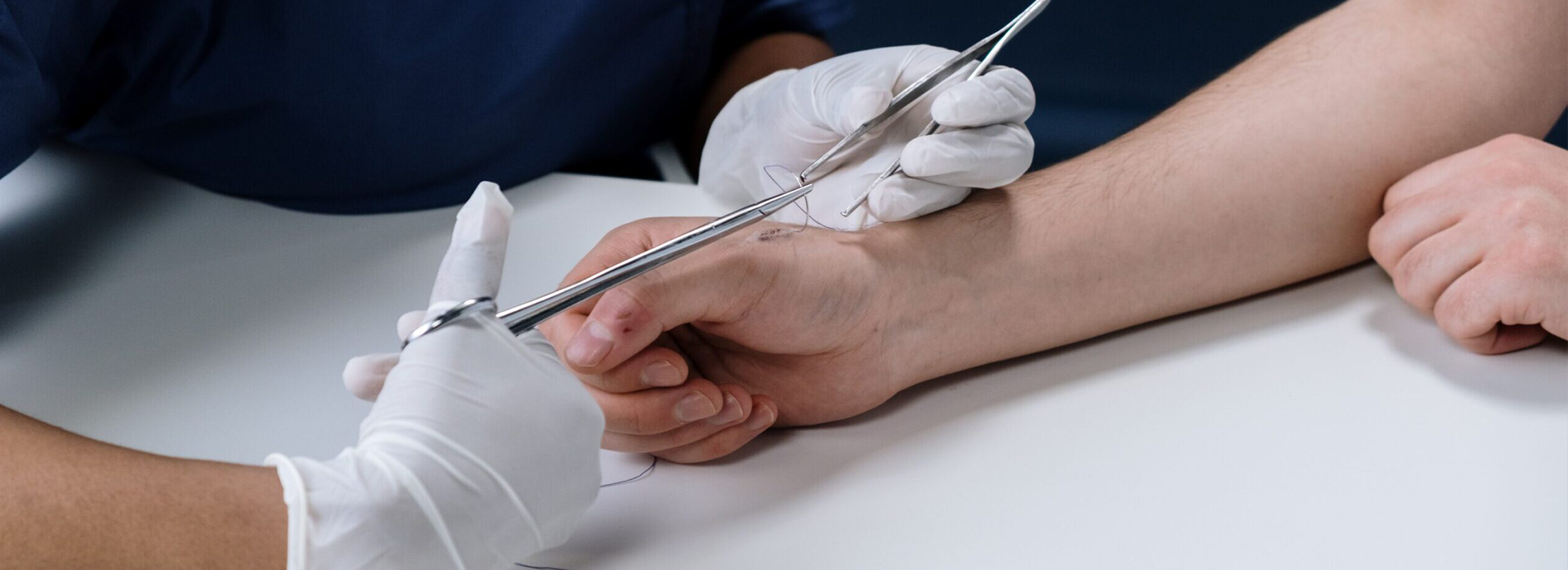
Sometimes it’s hard to tell if an open wound needs stitches. Stitches will help the cut heal properly and reduce scarring. If you’re not sure whether a wound requires stitching here are some helpful tips and methods you can use to find out if your open wound is really in need of medical attention.
Some wounds can be stitched and cared for at your local urgent care. While others may need serious medical care at your local Emergency Room.
Stop The Bleeding:
The most important focus should be to stop the bleeding. Use a clean cloth or slightly damp paper towel, and apply firm pressure to the open wound for about 5 minutes.
Remove it to check if it’s still bleeding. If it’s bleeding uncontrollably, do not proceed to any other steps and dial 911 immediately. If the open wound stops bleeding, follow the helpful tips below.
Carefully Analyze The Open Wound:
Is the open wound caused by a puncture from an object? Usually puncture wounds go into the skin and come back out or the item that caused the puncture can still be in the skin. This is called an “impaled object”.
Puncture wounds have more of a hole rather than a spread break in the skin like lacerations do. These can also come from animal bites.
Lacerations:
Lacerations are similar to puncture wounds since they both cause a break in the skin. Lacerations typically have length and depth, unlike puncture wounds. Lacerations are what are commonly known to us as a “cut”.
Reopened Surgical Wound:
Is it an accidentally reopened surgical wound? Surgical wounds are caused by scalpels. They are similar to lacerations, but the edges of the skin aren’t as ragged and uneven. More in fact, smoothly cut.
Avulsion: Torn Skin
Is the open wound an avulsion? Avulsions are caused by skin being torn in sections, flaps or numerous areas torn away completely with no skin.
Abrasions:
Is it an abrasion? Abrasions are scratches, scrapes or minor cuts that go no deeper than the epidermis, the top layer of skin. Determining if it needs stitching is the depth of the abrasion. If it’s a deep cut, then a laceration or an avulsion can occur, depending on the shape.
Does The Wound Need Stitches?
Now that you’ve got a good idea of what kind of wound you have, evaluate if the open wound needs stitching.
Here are three ways to do so:
- Look at the depth of the open wound.
- Is the open wound deep enough to where you can see yellow, fatty tissue?
- Is bone exposed?
- Is there a lot of flesh exposed?
- Is the wound more than 1/4 inch (6 mm) deep? If so, the wound could be eligible for stitching.
Step 1:
Look at the width. Can the wound be pulled together easily or pinched together with ease?
Usually a bandage and gauze can do this for you. The wound can scab over in less than 12 hours by itself to start healing. If the wound is too wide to be held together with bandaging, then it will need stitching. This will pull the skin together so it can heal correctly.
Step 2:
Look at the location of the open wound. If the open wound is located in a specific area of the body where there is a lot of movement involved, it will most likely need stitching. This is to prevent the re-opening of the wound caused by movement and stretching of the skin.
An open wound on the legs or fingers (especially where joints connect) would be eligible for stitches. If an open wound is on the forehead it would not really need stitching. However, the other two steps apply and should all be taken into consideration if it’s a cut on the forehead. Depth and length play a big part in the determining of stitching also. Keep this in mind.
Step 3:
How long has it been since you had a tetanus shot? Tetanus shots last no longer than 5 years. You will need to get re-vaccinated. Your local urgent care center can always provide this service.
If you have not had a tetanus shot in over 5 years, go to the hospital. While you are at the hospital, you can have the doctor evaluate the cut also to see if it will need stitching.
Other Types of Wounds and Proper Care:
Numerous types of wounds should always receive the attention of a doctor, such as:
- Animal or human bites
- Debris that can’t be removed from the wound.
- Puncture wounds also qualify for this if the object cannot be removed without help from medical specialists.
- Uncontrollable bleeding: seek medical attention immediately, or dial 911.
- If you or the injured are diabetic.
- Edges of the wound cannot be closed together.
Caring For A Wound or Cut:
Always be sure to check for sign of infection. This could be redness, swelling, fever, green ooze or puss, and a red streak.
Preventing infections are crucial. Be sure and use antibiotic ointment and basic first aid dressings to continue healing of your wound or cut. Always keep the wound clean and soak when needed.
If you suspect a wound is infected, make sure to visit your local urgent care for proper treatment. Doctors can prescribe antibiotic treatment along with wound care to heal the infection.

